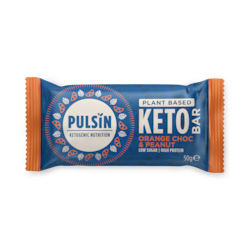20% off £30
Is the keto diet safe - and what side effects should you expect?

With its promise of weight loss, increased energy and balanced blood sugar – the ketogenic diet might seem like the diet to top all others.
It’s even thought to be able to melt away belly fat – the dangerous visceral fat which lurks inside your abdominal cavity.1
But is keto safe? As with all diets it’s a good idea to take a moment to consider the risks and benefits, whether it’s suitable for you and whether it’s healthy to follow in the long term.
What is the keto diet?
The keto diet is known to be effective for quick weight loss, but it’s not without its risks.2
The ketogenic or keto diet is a high-fat, medium-protein and very low-carbohydrate eating plan which aims to trigger a state of ketosis in the body. This is when the body burns fat as its preferred energy source rather than glycogen from carbohydrates, which is the usual primary source of energy production in body tissues.3
When following the standard ketogenic diet, the diet should consist of 5% carbs, 20% protein and 75% fat.4 These percentages change slightly depending on which exact plan you follow, but the hallmark of a keto diet is that most of your daily calories will come from fats like butter, cheese, oil, meat, nuts and avocadoes.
Keto doesn’t permit starchy vegetables and most fruits are off the menu too, as they’re too high in carbohydrates. The wilful cutting out of foods known to be nourishing to the body is why some people think the keto diet is too restrictive.
The keto diet was originally developed as a therapeutic diet for epilepsy by doctors in the 1920’s, the keto diet has exploded in popularity during the 21st century due to its potential for rapid and significant weight loss.5
Is the keto diet safe?
As with any diet, it’s sensible to consider the risks beforehand.
There are some side effects you may have to contend with after starting keto, especially at first. You should also be aware of some more serious risks of the keto diet – as well as whether you’re better off avoiding keto altogether.
What are the negative effects of the keto diet?
-
Keto flu
This is the name given to a collection of symptoms that some people experience after beginning a keto diet. These side effects are thought to be side-effects of the body entering ketosis.
These symptoms are common and relatively minor, with most resolving themselves within a couple of weeks. These symptoms include6:
- Nausea
- Vomiting
- Headaches
- Fatigue
- Dizziness
- Trouble sleeping
- Constipation
Making sure you drink lots of water and getting enough rest may help alleviate these symptoms.
-
Nutrient deficiency
A key risk with any diet is that you miss out on vital vitamins, minerals or macronutrients (such as protein, carbohydrates or fat).
As the keto diet is rich in fat, and contains a moderate amount of protein, the risks of becoming deficient in these are low.
However, the lack of fruits and vegetables on keto can lead to low levels of certain vitamins, including vitamin C, vitamin A, B vitamins and magnesium.
The best way to remedy this is to make sure you always include some of the keto-friendly fruits and vegetables in each meal. These include7:
- Broccoli
- Cauliflower
- Peppers
- Courgette
- Spinach
- Green beans
- Kale
- Avocadoes
- Raspberries
- Watermelon
You might want to consider taking a supplement which contains vitamin C, vitamin E, vitamin A, B vitamins and magnesium to take to make sure you don't miss out on these nutrients.
-
Leg cramps
Leg cramps, usually at night, are a common side effect of the keto diet. This is thought to be down to low levels of electrolytes such as magnesium and potassium in the body, which causes nerve sensitivity and involuntary muscle spasms.8
Leg cramps usually settles down after a few days on the keto diet, but if they don’t – eat more dark leafy greens, nuts and seeds, or consider a magnesium and potassium supplement.
-
Changes in bowel habits
The emphasis on fats such as cream, butter and oil in the keto diet – as well as a lack of fibre – can spell big changes to your usual toilet habits.
A major side effect of the keto diet – especially in the early days – is constipation.
To address this, increase your intake of keto-friendly vegetables and leafy greens. A fibre supplement such as one made from psyllium husk or linseeds can help keep you regular while your bowels adjust.
-
Bad breath
Unfortunately, ‘keto breath’ is a thing.
Breath that smells fruity, metallic or like nail varnish remover is a possible side effect of the state of ketosis – when your body burns fat as fuel.9
This is down to the presence of ketones – the chemicals released when fatty acids are burned by the body.10
Keto breath is a sign that you’re in ketosis and is especially likely when you’ve just begun the keto diet and your body is adjusting.
-
Low mood
People often overlook the effect of starting a new diet on our mental wellbeing. If you’re used to eating lots of carbohydrates and sugary things, these foods may have a sense of pleasure or comfort attached.
The first week or so of the keto diet is very much an adjustment period, so try to go easy on yourself during this time.
More serious side effects
-
Hypoproteinemia
This is a condition where there are very low levels of protein in the blood.
It has been linked with the keto diet, and although it’s not definitively known why keto can trigger hypoproteinemia, it’s thought to be due to the relatively low amounts of protein consumed on some keto diets.11,12
-
Kidney stones
People following the keto diet can be prone to developing kidney stones.
Most studies around this issue have focused on children with severe epilepsy, for which the ketogenic diet is sometimes recommended by doctors. One study found that 6% of children who eat a keto diet go on to develop kidney stones.13 Potassium supplementation is known to relieve kidney stones is many such cases.14
It’s thought that dehydration and low magnesium are also factors in developing kidney stones on the keto diet, so prioritise getting enough water and electrolytes.15
-
High cholesterol
With its apparent free pass to eat lots of meat (including fatty and processed meat), butter, cream and cheese, the keto diet can lead to the consumption of lots of cholesterol.
The keto diet also restricts foods associated with heart health, such as whole grains, legumes and a wide variety of fruits and vegetables.
There have been concerns raised by heart-health experts over the rise of the keto diet, especially when followed long-term (for more than two years) as the effects on cardiovascular health are unknown.16
Who should not follow a keto diet?
The keto diet isn’t suitable for everyone, including people with:
-
Liver problems
People with non-alcoholic fatty liver disease (NAFLD) are not good candidates for the keto diet. It’s thought that adding a large amount of fat to your diet as with keto can make NAFLD worse.17
-
Pancreatitis
A high-fat diet such as keto can lead to hyperlipidemia – too much fat in the blood.
The pancreas is involved with processing the fat we eat, so consuming too much fat can cause it to work overtime, possibly making pancreatitis worse.18
-
Fat metabolising disorders
If your body has a problem metabolising fat, such as is the case with rare conditions such as Gaucher disease or Tays-Sachs disease, then the keto diet – which relies on taking large amounts of fat daily - isn’t for you.
This is because we use enzymes to break down fat in the body – and without enough of these enzymes the body will risk hyperlipidemia.19
-
Hyperthyroidism
When your body doesn’t produce enough thyroid hormones, it’s sensible to avoid eating too many carbohydrates to avoid weight gain. However, eating too few carbs, such as on the keto diet, interferes with your ability to regulate thyroid hormone levels.20
The final word
We asked Nutritionist Alexander Thompson – is the keto diet safe long term?
“The keto diet is a fairly new diet, meaning there isn’t a huge amount of evidence on what the long-term effects might be. What we do know though is that the keto diet may not suitable for some people with certain health conditions or taking certain medicines.
This makes it important for these people to talk to their doctor before starting the keto diet. Also, people should be selective over the type of fat they ingest when following the diet, with animal fat kept to a minimum, instead opting for high fat vegetable foods like oils, nuts & seeds and avocados. This important in terms of heart health.”
Last updated: 16 April 2021
- https://pubmed.ncbi.nlm.nih.gov/27623967/
- https://www.ncbi.nlm.nih.gov/books/NBK499830/
- https://www.ncbi.nlm.nih.gov/books/NBK499830/
- https://www.ncbi.nlm.nih.gov/pubmed/17332207
- https://pubmed.ncbi.nlm.nih.gov/19049574/
- https://www.ncbi.nlm.nih.gov/books/NBK499830/
- https;//www.eatingwell.com/article/291245/complete-keto-diet-food-list-what-you-can-and-cannot-eat-if-youre-on-a-ketogenic-diet/
- https://ketogenic.com/quick-tips/what-are-the-benefits-of-magnesium-on-keto/
- https;//www.diabetes.co.uk/keto/side-effects-of-ketogenic-diet.html
- https://www.ncbi.nlm.nih.gov/pmc/articles/PMC4737348/
- https://www.ncbi.nlm.nih.gov/books/NBK499830/
- https://pubmed.ncbi.nlm.nih.gov/25724370/
- https://pubmed.ncbi.nlm.nih.gov/19596731/
- https://pubmed.ncbi.nlm.nih.gov/17621514/
- https://www.virtahealth.com/faq/ketogenic-diet-kidney-stones
- https://www.heartuk.org.uk/news/latest/post/121-ketogenic-diet-and-lipids-
- ttps://www.nutraingredients.com/Article/2019/09/03/Keto-diet-could-damage-liver-health-say-experts
- https://pubmed.ncbi.nlm.nih.gov/11575609
- https://medlineplus.gov/lipidmetabolismdisorders.html
- https://pubmed.ncbi.nlm.nih.gov/11167929/



































